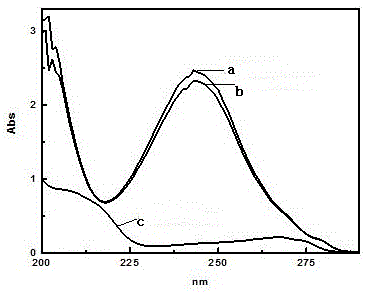Application of Bacillus in degrading aromatic compounds
A technology of aromatic compounds and bacillus, applied in the field of microorganisms, can solve the problems of incomplete pollution, secondary pollution by chemical methods, changes in locations, etc., and achieve the effects of low cost, no secondary pollution, and high degradation efficiency
- Summary
- Abstract
- Description
- Claims
- Application Information
AI Technical Summary
Problems solved by technology
Method used
Image
Examples
Embodiment 1
[0028] Embodiment 1: bacillus L1 ( Bacillus ligniniphilus L1) Degradation effect on 3,4-dihydroxybenzoic acid
[0029] Bacillus L1 ( Bacillus ligniniphilus L1) was isolated and screened from the seabed mud of the South China Sea, and its isolation, screening and identification process are detailed in the article: (Zhu D , Tanabe SH , Xie C , Honda D , Sun J , AiL.Bacillus ligniniphilus sp. nov., an alkaline and halotolerant bacteria isolated from sediments of the South China Sea. International Journal of Systematic and Evolutionary Microbiology. DOI: 10.1099 / ijs.0.058610-0).
[0030] The detailed process descriptions such as the screening, isolation and identification of the bacteria have been published, and are materials well known to those skilled in the art.
[0031]This example investigates the degradation of Bacillus L1 to different concentrations of 3,4-dihydroxybenzoic acid. The main steps are as follows: the bacteria were enriched in the enrichment medium (tryptone...
Embodiment 2
[0037] Embodiment 2: bacillus L1 ( Bacillus ligniniphilus L1) Degradation effect of 3-methoxy-4-hydroxybenzoic acid
[0038] The main steps are the same as in Example 1, and the inoculum size of 3% (V / V) is inoculated to the sterilized initial concentration of 100, 500, 1000, 1500 and 2000 mg / L of 3-methoxy-4-hydroxyl respectively. Benzoic acid is used as the only carbon source in the inorganic salt medium, and the temperature is 28° C., and the rotation speed is 180 rpm. Such as Figure 4 Be the degradation curve of the 3-methoxyl-4-hydroxybenzoic acid of 500mg / L for Bacillus in different time periods, Figure 4 It can be seen that there is a characteristic absorption peak at 275nm, and the concentration c is linearly correlated with the absorbance A, c=352.11A+17.43, using ultrapure water as a control, the absorbance at 275nm is used as the measurement index of p-hydroxybenzoic acid concentration and calculated Degradation rate.
[0039] The result is as Figure 9 show...
Embodiment 3
[0040] Embodiment 3: bacillus L1 ( Bacillus ligniniphilus L1) degradation effect of catechol
[0041] The main steps are the same as in Example 1, and the catechol of 100, 500, 1000, 1500, and 2000 mg / L is inoculated to the sterilized initial concentration as the only carbon source inorganic In the salt medium, shake culture at a temperature of 32° C. and a rotational speed of 150 rpm. Such as Figure 6 It is the degradation curve of 500mg / L catechol in different time periods for Bacillus, Figure 6 It can be seen that there is a characteristic absorption peak at 273nm, and the concentration c is linearly related to the absorbance A, c=490.20A+24.92. Taking ultrapure water as a control, the absorbance at 273nm is used as the measurement index of catechol concentration and calculated Degradation rate.
[0042] The result is as Figure 10 shown. Under the condition of 32°C, the degradation rates of catechol with the initial concentration of 100, 500, 1000, 1500 and 2000 m...
PUM
 Login to View More
Login to View More Abstract
Description
Claims
Application Information
 Login to View More
Login to View More - R&D
- Intellectual Property
- Life Sciences
- Materials
- Tech Scout
- Unparalleled Data Quality
- Higher Quality Content
- 60% Fewer Hallucinations
Browse by: Latest US Patents, China's latest patents, Technical Efficacy Thesaurus, Application Domain, Technology Topic, Popular Technical Reports.
© 2025 PatSnap. All rights reserved.Legal|Privacy policy|Modern Slavery Act Transparency Statement|Sitemap|About US| Contact US: help@patsnap.com



